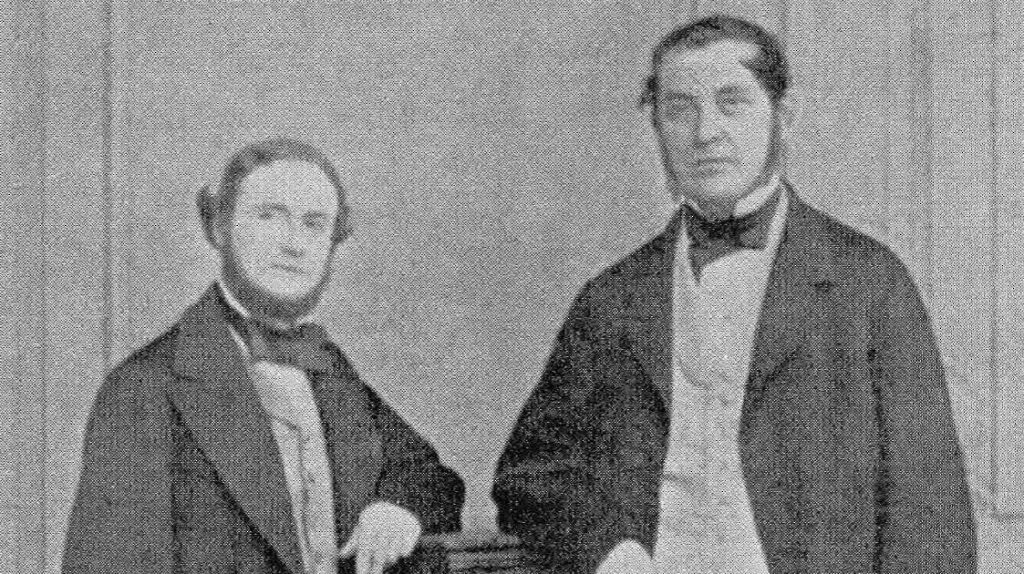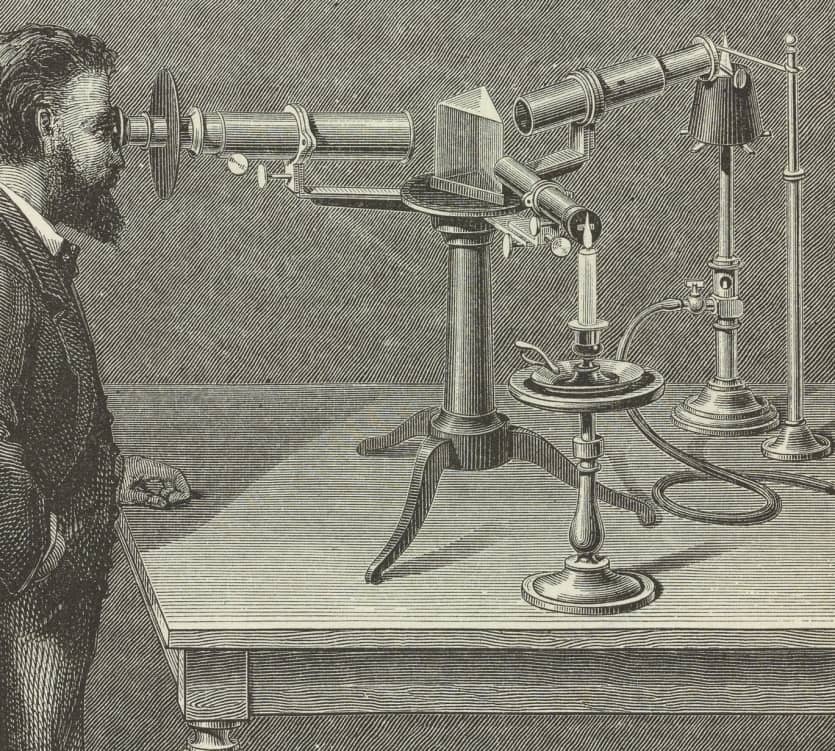Did spectroscopy, the study of how light is emitted and absorbed by heated objects, really revolutionize the sciences and fundamentally shift our understanding of the world? In short… yes! In Chemistry, spectroscopy quickly caused the identification of new elements and infrared spectroscopy is still used in chemical analysis to this very day.
In Astronomy, spectroscopy allowed us to figure out what the sun and stars are composed of and is still the most powerful tool in an Astronomer’s toolbox. And Physics? Ah, that is where it had the most influence, for it was spectroscopy that directly led to the development of quantum mechanics!
And all of this began when a shy small physicist named Gustav Kirchhoff suggested that his friend, a large absentminded chemist named Robert Bunsen, use a prism.
Table of Contents
Kirchhoff and Bunsen
How Spectroscopy was discovered
References
Kirchhoff and Bunsen

Edgar Fahs Smith Collection, Kislak Center for Special Collections, Rare Books and Manuscripts, University of Pennsylvania
Kirchhoff and Bunsen met because of a revolution, several revolutions actually. See, in 1848, Gustav Kirchhoff had won a scholarship to travel from Prussia to France for his astonishing work that he had done as an undergrad on how complicated circuits follow Ohm’s law that is still causing students in Engineering and Physics to butcher the spelling of his name today.
However, the year was the start of, according to Wikipedia, “the most widespread revolutionary wave in European history”. Therefore, Kirchhoff only made it as far as Berlin. Undeterred, Kirchhoff talked himself into a temporary position at the University of Berlin and then the University of Breslau where he became close friends with a visiting Chemist named Robert Bunsen.
Bunsen was a renowned chemist and also a total character famous for his eccentric habits, in fact, he was so known for his quirks that his friends wrote an entire book about his “humorous stories”! Bunsen was a lifelong bachelor, although according to legend, he did once ask a woman for her hand and had been accepted.
However, he had then gotten so involved in his research he forgot to talk to his fiancée for several weeks and then forgot even whether he had actually proposed. Undeterred, he just went to the young lady and proposed again. Insulted, she changed her mind and “promptly showed him the door”[1].
Anyway, in 1852, Bunsen got a Chemistry position at the University of Heidelberg and used his influence to help young Kirchhoff get a Physics professorship there too.
Then, in 1856 Bunsen heard that the town was to be supplied with gas to light street and home lamps at night[2] and worked out a deal with the gas company to supply his laboratory with gas during the day. Bunsen then realized that the gas burners available were unsteady and did not produce a lot of heat.
How Spectroscopy was discovered

He then set out to make a superior gas burner and by 1857, published a description of the “Bunsen burner”, a device still in use in Chemistry laboratories throughout the world. However, Bunsen would never think of patenting his device writing that, “working is beautiful and rewarding, but the acquisition of wealth for its own sake is disgusting.[3]”
Bunsen thus had a very good heat source to play with and decided, as he was a chemist, to systematically study the light produced by different chemical salts when they burned. Bunsen tried to quantify the colors by studying them through colored filters, which did not work very well.
One day in 1859, Bunsen mentioned his irritation to Kirchhoff who wondered why he didn’t just use a prism. Physicists had known since Newton’s time that prisms bend different colors by different amounts and could make a rainbow. However, when they looked at heated low-density gasses it did not produce a rainbow!
In fact, it would make sharp bars of specific frequencies called spectral lines. Note that Bunsen and Kirchhoff were not the first people to look at spectral lines with a prism, they weren’t. What made this different is that Kirchhoff was suggesting they use a prism with a moveable scope, which allowed them to measure the specific colors that the chemicals made.
They soon found that each element had its own unique “optical fingerprint”. What is going on? Well, the electrons in gasses are bound to the nucleus and can only exist at different set energy levels. When they are heated, they will jump up levels, and then, when they fall back down they release a photon of light whose energy (and color) depends on the change in energy levels.

Different elements have different energy levels so they produce different bands of light.
Bunsen and Kirchhoff built their first spectroscope out of Bunsen’s old cigar box, some telescope parts, a prism, and, of course, a Bunsen burner. Despite being crude this was a surprisingly sensitive device. Bunsen noted that, “chemistry produces no single reaction which in the remotest degree can compare in… sensitiveness.[4]”
They found, for example, that they could see sodium when as little as 1/20,000,000th of it was suspended in smoke[5]! Moreover, you could burn chemicals made of several elements and determine from these “fingerprints” what they are composed of. Bunsen and Kirchhoff burned some compounds and found some fingerprints that didn’t correspond any known chemical and, in this way, discovered two unknown chemicals: rubidium and cesium.
That is not all, in October, Kirchhoff was studying the “fingerprint” from sodium and as a lark decided to see what happened if he added the light from a bright lamp. Kirchhoff knew that his lamp, like most heated liquids (and solids and plasma gas) would produce basically a continuous spectrum, or a rainbow.
Therefore, with a lamp and heated sodium, he expected to see a rainbow with two bright yellow lines from the sodium. To Kirchhoff’s shock, he got a rainbow with two black bands in the yellow, “exactly at the spots where the bright lines were supposed to show.[6]” Excitedly, this rainbow with black “shadows” looked just like the spectrum from the sun as the sun is not a smooth spectrum but actually has little dark lines in it, which can be seen with a very good prism and a microscope.
The fact that sunlight has black bars was first discovered in 1802 but was made famous 12 years later by a German glassmaker named Joseph Fraunhofer who counted over 570 lines in sunlight. Kirchhoff, therefore, realized that he was recreating the Fraunhofer lines of sunlight with lamplight and sodium. It seemed immediately clear to Kirchhoff that the shadows in sunlight must be due to sodium gas on the sun.
Let me explain in more detail, as this is both really amazing and a bit complicated. The sun is hot plasma, where the elements are so dense and hot that the electrons are ripped free from their atoms and are free to move. Therefore, the electrons in plasmas produce a continuous spectrum of light.
The atmosphere of the sun, however, has spots cool enough for the elements to be in gas form instead of plasma form, although they are still ridiculously hot, hot enough that even the metals are in gas form. As these gases are cooler than the sun, they absorb more radiation than they produce.
Therefore, the gas elements in the atmosphere of the sun will leave the “shadows” of their optical fingerprints in sunlight. By studying the optical fingerprints of elements on Earth and comparing to the shadows in sunlight Kirchhoff had found a way to determine what the sun is composed of!
Soon, Kirchhoff and Bunsen found many different elements in the sun[7] (but no helium, as helium was only discovered because of its shadows in sunlight which is why helium is named after Helios, the Greek Sun god!). Kirchhoff and Bunsen even found trace amounts of gold in the sun!
It’s true, around a 60 of a billionth of a percent of the sun is made of gold gas. But, as the sun is so large, there is about as much gold in the sun as water in the oceans of Earth! Kirchhoff liked to tell a story of how his banker was unimpressed to learn that this method was proving that there are trace amounts of gold in the sun, as he couldn’t bring it to Earth and put it in the bank! Soon after, Kirchhoff won a prize for this work and told his banker, “Look here, I have succeeded at last in fetching some gold from the sun.[8]”
But wait, we aren’t done yet! In 1860, Kirchhoff wrote a theoretical paper about the emission and absorption of light. In this paper, Kirchhoff imagined a “perfect” object that would “completely absorb all incident rays,” which he called “perfectly black, or, more briefly, black bodies[9].”
If it absorbed all incident light then any light that it radiates comes from the substance itself being heated. Kirchhoff theoretically predicted that the intensity of the radiation would only depend on the temperature of the material and the frequency of the light although he didn’t have a theoretical form for this equation.
Kirchhoff said, “to determine this function is a matter of the greatest importance,[10]” although he was sure of success, “since the form of the function in question is no doubt simple.[11]” The equation turned out to be pretty simple, but it was very difficult to create the experiment and find a good theoretical logic behind it.
In fact, it took 40 years to solve the “black-body” radiation puzzle. In 1900, a man named Max Planck wrote a paper deriving the blackbody equation where, as he put it, “the most essential point of the entire calculation [is that] energy [is] composed of a very definite number of equal finite packages.[12]”
Five years later, Einstein called these “energy elements”, “quanta of light”[1]!In other words, in 1900 Max Planck stated the quantum mechanics revolution because of blackbody radiation! And that story is next time on the lightning tamers.
References
[1] Quanta is bastardized Latin for packets, quantum is the singular.
[1]Oesper, R “Robert Wilhelm Bunsen” Journal of Chemical Education vol. 4 No. 4 1927 p. 434-5
[2] Roscoe, H “Bunsen Memorial Lecture” Royal Institute of LondonVol. 16 (1900) p. 442
[3] Bunsen, W recalled by Jensen, W. “Robert Bunsen’s Sweet Tooth” p. 8 published in Patterson et. all Characters in Chemistry: A Celebration of the Humanity of Chemistry
[4] Bunsen, R and Kirchhoff, “Chemical Analysis by Spectral Observations“ The Laws of Radiation and Absorption p. 108
[5] Bunsen, R and Kirchhoff, “Chemical Analysis by Spectral Observations“ The Laws of Radiation and Absorption p. 108
[6] Helmholtz, R “Gustav Robert Kirchhoff” The Open Court Vol. 2 (1889) p. 785
[7]paper is in German but referenced in Brand, J Lines of Light (2017) p. 132
[8] ‘Memoir of Kirchhoff’ by Helmholtz “Annual Report of the Board of Regents of the Smithsonian Institution” Volume 1889p 537
[9] Kirchhoff, G “On the Relation between the Radiating and Absorbing Powers of Different Bodies for Light and Heat” Phil Magazine Vol. 20 Vol. 4 (July, 1860) p. 2
[10] Kirchhoff, G “On the Relation between the Radiating and Absorbing Powers of Different Bodies for Light and Heat” Phil Magazine Vol. 20 Vol. 4 (July, 1860) p. 12
[11] Kirchhoff, G “On the Relation between the Radiating and Absorbing Powers of Different Bodies for Light and Heat” Phil Magazine Vol. 20 Vol. 4 (July, 1860) p. 13
[12]referenced in p. 96 “Genius” Walter Isaacson
/*54745756836*/
2 responses to “How Spectroscopy Changed the World”
Blimey !! 😀
I just discovered these scripts… after having translated/summarized most of your spectroscopy’s series in french for my astronomy club ^^
Your work is admirable ! Thank you soooo much !
Elsa,
So sorry if you found the scripts a little late to help with translating. If you have material in French and you want to share it, please email me at kathylovesphysics@gmail.com and I will try to find a way to post it on my site.
So glad you liked the material (have you seen the one on Norman Lockyer yet? it might be very interesting to an astronomer?). Anyway, thanks again,
Kathy